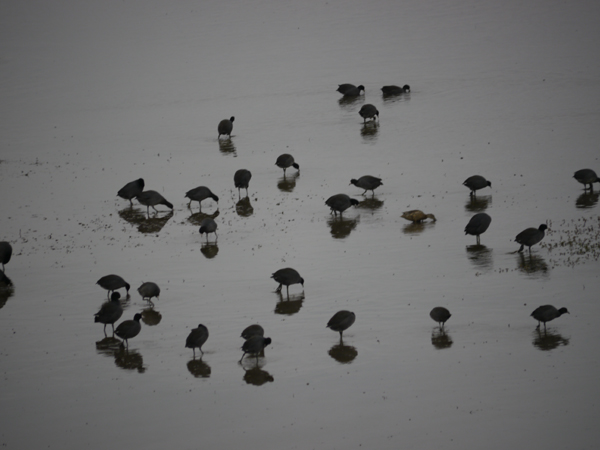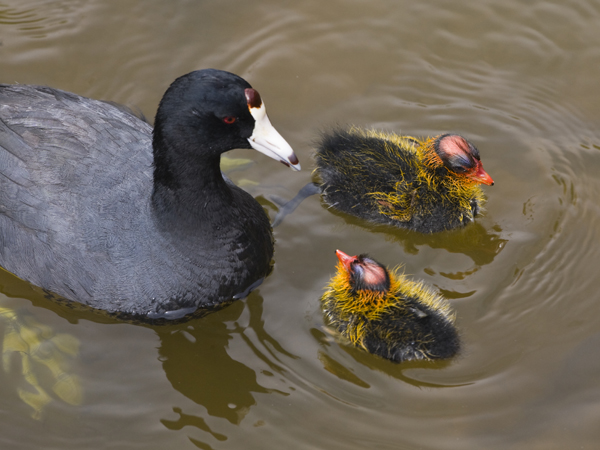By Matt Miller, senior science writer
Most baby birds, cute though they may be, are not exactly colorful. This makes good evolutionary sense: Newly-hatched birds, unable to fly, make easy meals for predators.
They thus must blend into their surroundings. A drake mallard or canvasback is a colorful, striking water bird, but baby ducks are nondescript. They disappear into the marshy reeds, making it harder for a hungry raccoon or mink to find them.
Not so the American coot.
Adult coots are fairly drab birds. But their babies? They look like they were designed by a deranged tattoo artist.
The front half of the coot’s body is covered in orange-tipped plumes, giving them a jarring appearance. We’re not used to seeing baby birds covered bright feathers. While this orange fades rather quickly—in about six days—it still leaves them conspicuous when they are at the most vulnerable stage of their lives.
This coloration makes them more susceptible to predation. What advantage would such feathers possibly confer?
Research published in Nature has shown that female coots favor babies with brighter plumes. When biologists removed plumes from chicks, the mothers showed a preference for the more colorful offspring. Being a colorful baby coot may draw attention from a fox, but it also means more food and better care, thus increasing chances of survival.
Adult coots compensate for their cartoonish young by being fierce defenders of their nests. Many predatory species find that attacking coots not worth the trouble.
Curiously, adult coots are somewhat unwieldy fliers, so they’re easy prey for many raptors, including bald eagles.
Coots face another peculiar challenge during nesting season. Nest parasitism—laying eggs in other coots’ nests—is common. As many as 40 percent of nests contained eggs laid by other coots.
Nest parasitism is not uncommon among birds. But what is uncommon is that the coot has evolved a way to help recognize its own young (something only three bird species do).
According to researchers from the University of California-Santa Cruz, coots can count their eggs and reject those laid by other coots. They also use hatching order to help differentiate between their own chicks and parasites (chicks that hatch first are more likely to be their offspring).
Chicks that are identified as “intruders” are rejected, to put it mildly: Researchers report adults chasing them away from the nest, violently pecking them and even forcing them underwater to drown them.
Sometimes, though, adult coots misidentify their own young as parasites and raise the actual parasites as their own. It obviously happens often enough for this habit to continue.
Coots are one of the most common birds you’ll see in wetlands, ponds and lakes around the United States.
They often converge in huge flocks (called rafts). Biologists counting birds a the restored wetlands of the Conservancy’s Emiquon Preserve in Illinois, for instance, have recorded as many as 135,000 coots in a single day (or about four to five percent of the global population).
As drab, common birds, many people might overlook coots in favor of more colorful and rarer species. But this spring, look carefully. You may be rewarded with the sight of those clownish baby coots – and all the natural drama that surrounds them.

Photo credits: Baby coots by Mike Baird/Flickr under a Creative Commons Attribution 2.0 Generic license. Emiquon coots by Matt Miller/TNC.
Opinions expressed on Cool Green Science and in any corresponding comments are the personal opinions of the original authors and do not necessarily reflect the views of The Nature Conservancy.




that is not a coot!
It is indeed a coot.
On my walks I noticed that the Coots tend to swim away from the shoreline as I come near but after a time they return to the same spot after I have moved a proper distance away. What type of “food” ,would you recommend. would be healthy and yet attract them? Because I would love to see their chicks.
Richard,
Thanks for your question. American coots eat mainly vegetation including pondweed, sedges and algae. As such, a human food source is unlikely to attract them. Also, feeding of waterfowl is not recommended and is illegal in many locales. It concentrates birds, leading to disease, and many foods that people commonly feed them is unhealthy for waterfowl.
Matt Miller
Very interesting article and newsworthy. I was not aware of the coot chicks having such a distinguished look even if it only last a few days Thank you for this article.
I’ve been a wildlife rehabilitator for 12 years. Please don’t feed breadcrumbs to waterfowl. They’ll fill up on it in lieu of more nutritious fare.
A diet of breadcrumbs has been shown to cause an incurable disease known as “angel wing.” It’s tragic to see.
https://en.wikipedia.org/wiki/Angel_Wing
Coots are omnivirous and their natural diet consists of plant material, especially algae; insects, fish, and mollusks. Bread doesn’t factor into a healthy diet at all.
I visit our Dare Valley Country Park regularly, and love to photograph nature at its best. This year I have enjoyed the activity of a family of coots. They have a family of 6 chicks and their nest made from sticks and bits’n’pieces seem to float in the middle of the lake. I hadn’t realised how large their ‘feet’ really are, and how fast they are attacking seagulls and ducks that swim too near their chicks. When I throw breadcrumbs in to the lake they swiftly arrive at the bank near me and are soon feeding their hungry brood. I have taken a number of photos of the family.
Thanks Matt … you are right I have overlooked Coots … I had never even seen a photo of the chics in this stage …. great piece.